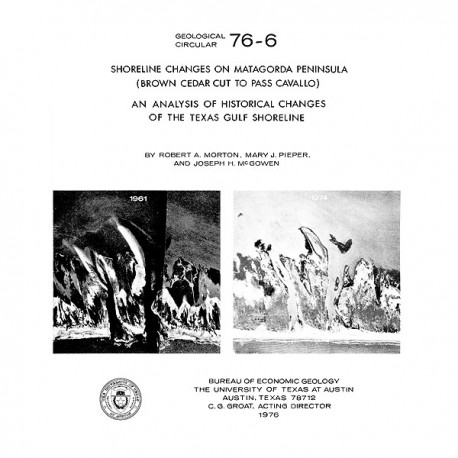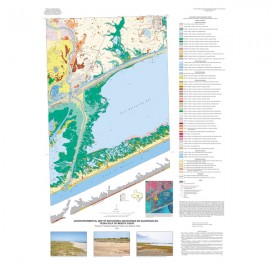Geological Circulars
-
Books & Reports
- Reports of Investigations
- Guidebooks
- Udden Series
- Geological Circulars
- Down To Earth
- Atlases of Major Oil and Gas Reservoirs
- Texas Memorial Museum Publications
- Environmental Geologic Atlas of the Texas Coastal Zone
- Mineral Resource Circulars
- Other Reports
- Seminars and Workshops
- Handbooks
- Submerged Lands of Texas
- Symposia
- Annual Reports
- Open File Reports
-
Maps & Cross Sections
- Thematic Maps
- Miscellaneous Maps, Charts & Sections
- Geologic Atlas of Texas
- STATEMAP Project Maps
- Geologic Quadrangle Maps
- Cross Sections
- Highway Geology Map
- Energy and Mineral Resource Maps
- Shoreline Change and Other Posters
- Wilcox Group, East Texas, Geological / Hydrological Folios
- Bouguer Gravity Atlas of Texas
- River Basin Regional Studies
- Featured Maps
- Posters
- Teachers & the Public
-
Geological Society Publications
- Gulf Coast Association of Geological Societies
- Alabama Geological Society
- Austin Geological Society
- Corpus Christi Geological Society
- Houston Geological Society
- Lafayette Geological Society
- Mississippi Geological Society
- New Orleans Geological Society
- South Texas Geological Society
- GCS SEPM Publications
- Historic BEG & UT Series
Shoreline Changes on Matagorda Peninsula (Brown Cedar Cut to Pass Cavallo)
GC7606
A free, digital version of this publication can be found on: Texas ScholarWorks
GC7606. Shoreline Changes on Matagorda Peninsula (Brown Cedar Cut to Pass Cavallo) An Analysis of Historical Changes of the Texas Gulf Shoreline, by R. A. Morton, M. J. Pieper, and J. H. McGowen. 37 p., 9 figs., 1 table, 3 appendices, 1976. ISSN: 0082-3309: Print.
To purchase this publication as a PDF download, please order GC7606D.
ABSTRACT
Historical monitoring along Matagorda Peninsula from Brown Cedar Cut to Pass Cavallo records the nature and magnitude of changes in position of the shoreline and vegetation line and provides insight into the factors affecting those changes.
Documentation of changes is accomplished by the compilation of shoreline and vegetation line position from topographic maps, aerial photographs, and coastal charts of various vintages. Comparison of shoreline position based on topographic charts (dated 1855-57) and aerial photographs (taken in 1937, 1956, 1965, and 1974) indicates short-term changes of accretion and erosion along Matagorda Peninsula from Brown Cedar Cut to Pass Cavallo. Erosion produces a net loss in land, whereas accretion produces a net gain in land. Comparison of the vegetation line based on the aforementioned aerial photographs indicates short-term cycles of erosion related to storms (primarily hurricanes) and recovery during intervening years of low storm incidence.
Long-term trend or direction of shoreline changes averaged over the 119-year time period of this study indicates net erosion between Brown Cedar Cut and Pass Cavallo, with the exception of a 3.5-mile segment north of Matagorda Ship Channel. Net accretion from the channel to a point 1.5 miles north of the channel was associated with jetty construction; the remaining 2-mile segment was influenced predominantly by short-term accretion between 1856 and 1937.
Average net erosion for Matagorda Peninsula was approximately 385 feet; however, average net erosion of 1,230 feet was recorded for a distance of 3.5 miles south of Brown Cedar Cut. Another segment where net erosion was far above average occurred on the southern end of the peninsula between Matagorda Ship Channel and Decros Point. There average net erosion was 950 feet.
In general, net rates of erosion and accretion were relatively low along Matagorda Peninsula, averaging about 2 to 3 feet per year. Net rates of erosion were greater than 10 feet per year south of Brown Cedar Cut and greater than 8 feet per year on the southern end of the peninsula between Matagorda Ship Channel and Decros Point. Because of limitations imposed by the technique used, rates of change are subordinate to trends or direction of change. Furthermore, values determined for long-term net changes should be used in context. The values for rates of net change are adequate for describing long-term trends; however, rates of short-term changes may be of greater magnitude than rates of long-term changes, particularly in areas where both accretion and erosion have occurred.
Major and minor factors affecting shoreline changes include: (1) climate, (2) storm frequency and intensity, (3) local and eustatic sea-level conditions, (4) sediment budget, and (5) human activities. The major factors affecting shoreline changes along the Texas Coast, including Matagorda Peninsula, are relative sea-level rise, compactional subsidence, and a deficit in sediment supply. Changes in position of the vegetation line are primarily related to storms.
Studies indicate that changes in shoreline and vegetation line on Matagorda Peninsula are largely the result of natural processes, perhaps expedited by man's activities. A basic comprehension of these physical processes and their effects is requisite to avoid or minimize physical and economic losses associated with development and use of the coast.
Keywords: shoreline change, beaches, Texas Gulf Coast, Matagorda Peninsula, Pass Cavallo, Brown Cedar Cut, Texas
Citation
Morton, R. A., Pieper, M. J., and McGowen, J. H., Shoreline Changes on Matagorda Peninsula (Brown Cedar Cut to Pass Cavallo) An Analysis of Historical Changes of the Texas Gulf Shoreline: The University of Texas at Austin, Bureau of Economic Geology, Geological Circular 76-6, 37 p.



